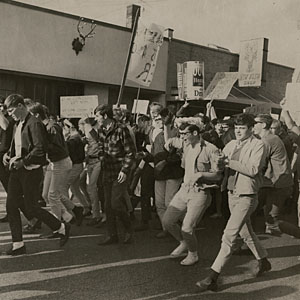Life At UW While Students Were Able To Drink Legally
Many people do not know that binge drinking was far from non existent before the drinking age change in 1986. The University underwent a series of attempts to reduce drunk driving and binge drinking on and around campus. For example, in 1911, the University implemented a five-mile dry zone around the campus. This was created to reduce the use of intoxicating liquors on and around campus. The university noted that there would still be students who would use liquor, however, they hoped to see a large reduction in the amount of liquor being consumed.
This dry-zone was removed shortly after, and the overall conclusion was that it did not significantly aid in the binge consumption of liquor on and around campus. The interesting part about this law was that it only pertained to University of Wisconsin- Madison students, and only inhibited the purchase and sale of liquor.
Another way that the University collaborated with the Madison police force in hopes of decreasing the amount of binge drinking going on at the campus was through bar times required for fraternity parties. There was a law that required frats to have a license to sell alcohol passed 12:45 am in their houses. The police really tried cracking down on this law in 1986, before the drinking age was changed.
Why did the drinking age change?
In 1986, the leading cause of death for the age group of 18-21 was automobile accidents. President Ronald Reagan sought to significantly decrease the death toll taken by drunk drivers of age 18-21. To do this, in 1986, he decided to give the states an extreme incentive to increase their drinking age from age 18 to 21. He linked his goal of decreasing the amount of drunk driving deaths to the incentives he provided for states to increase their drinking age by threatening to take federal highway funding. This way, if a state decided not to raise their drinking age, they would not receive 5% of the federal funds for their highways in the upcoming year, and 10% for every following year thereafter.
These incentives worked in the way that the President had intended; all states changed their legal drinking age to 21 following this bill. Some states had previously had a drinking age of 21, but Wisconsin was not in this group. Our legal drinking age changed to 21 in 1986, following this announcement from Ronald Reagan.
What were the effects of the new drinking age?
As stated previously, the main goal of the new drinking age was to decrease the amount of drunk driving accidents on a national scale. Was this goal achieved? Well, in order to understand this, it is important to look at the facts before and after the law change. According to Newsweek on Campus, the drunk driving deaths from the age group 18-21 are only slightly more than drunk driving deaths in the age group 22-24. It is hard to find specific statistics about the toll that the new drinking age took, however, according to an article written in 1996, Madison was listed as one of the top young and reckless areas for drinking and driving in Wisconsin. Clearly, there is still a fair amount of drinking and driving going on even after the law change.
Another main effect of the new drinking age was a huge increase in the amount of fraudulent identification seen on and around campus. Soon after the change, students were attempting to order beer at the union, or get into bars using fake ids and birth certificates. Kollege Klub reported confiscating between 350 and 400 fake ids in the fall of 1986. The persistence of such large groups of students to continue to drink, despite the law change, is one of many signs that the new law may have done little to prevent drunk driving accidents for this age group.
So what does this mean for me as a UW student?
Many undergraduate students are angered and upset by this law that prohibits them from going to bars and drinking with their older classmates. The important things to take away from the history of the drinking age change is to note that the goal was to significantly reduce premature deaths in the age group of 18-21. By peacefully protesting and presenting the facts to the (many) uneducated people on this subject, your voices will be heard. If the drinking age were ever to be changed back to 18, it is extremely important for this age group to prohibit drunk driving and be safe, proving that they are responsible enough adults to handle the privilege of drinking legally.



